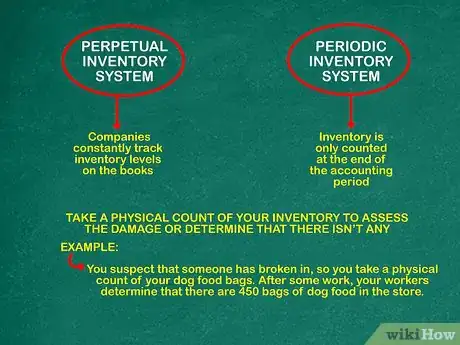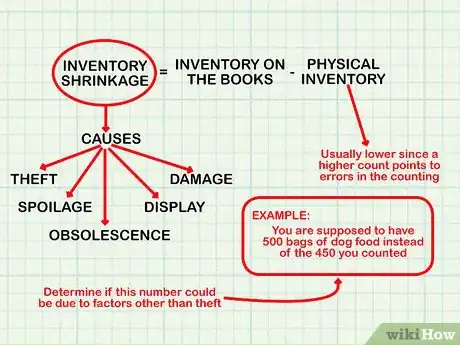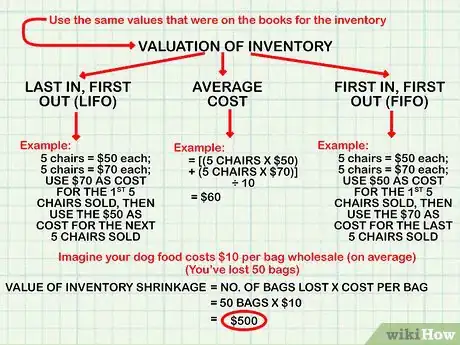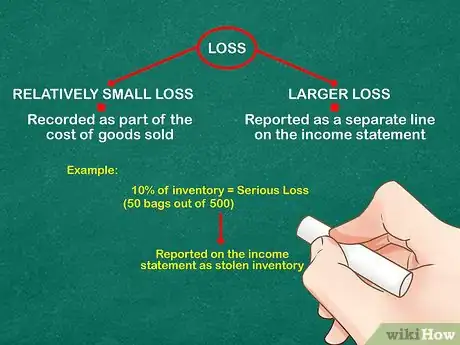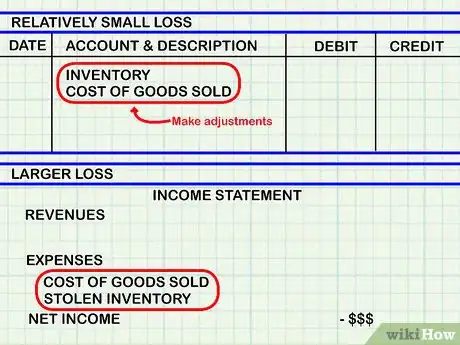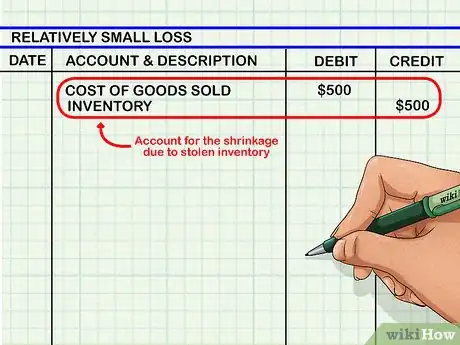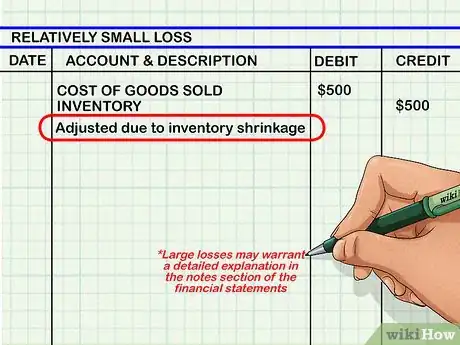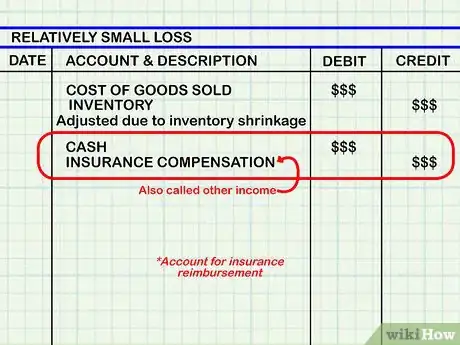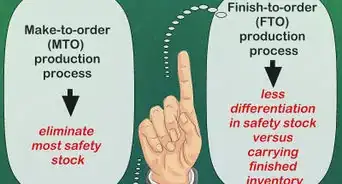This article was co-authored by Michael R. Lewis. Michael R. Lewis is a retired corporate executive, entrepreneur, and investment advisor in Texas. He has over 40 years of experience in business and finance, including as a Vice President for Blue Cross Blue Shield of Texas. He has a BBA in Industrial Management from the University of Texas at Austin.
This article has been viewed 116,523 times.
Retailers often employ special accounting treatments that aren't seen in other industries. Because inventory controls are so important to these companies, they have developed several methods for tracking and accounting for the flow of inventory, from production to final sale. An important adjustment required from merchandising companies is accounting for inventory shrinkage, which is the difference between the physical inventory count and the amount of inventory recorded in the books. Inventory shrinkage can result from several factors, including theft by either customers or employees. Learning how to account for stolen inventory will allow you to balance your inventory account with the physical count.
Things You Should Know
- Find the value of the missing inventory by comparing your actual inventory to the account balance on the books.
- For minor losses, debit cost of goods sold and credit inventory for the value of the loss.
- Report significant losses on your income statement.
Steps
Loss Assessment
-
1Take a physical count of the inventory. Retail companies tend to handle this in one of two ways: either the perpetual or periodic inventory system. Under the perpetual system, companies constantly track inventory levels on the books, whereas with the periodic system inventory is only counted at the end of the accounting period. Either way, you'll need to take a physical count of your inventory to assess the damage (or determine that there isn't any).[1]
- For example, imagine that you own a store that sells pet food. You suspect that someone has broken in, so you take a physical count of your dog food bags. After some work, your workers determine that there are 450 bags of dog food in the store.
-
2Compare the physical inventory count to the account balance on the books. In nearly all cases, the physical count will be lower (a higher count usually points to errors in the counting). This difference between the inventory on the books and physical inventory is referred to as inventory shrinkage.[2]
- Be careful to attribute this shrinkage to the correct causes. A large shrinkage is cause for alarm and should be further investigated. However, you can't assume that all of the difference is due to theft.
- Common causes of inventory shrinkage are theft, spoilage, obsolescence, damage, and display (items that have been put on display and are no longer fit for consumption). Cracking down on theft will not necessarily reduce these other factors.[3] Retail companies should have procedures and policies in place to deal with spoilage, damage, and obsolescence automatically if these cause significant shrinkage.
- For example, imagine that in the previous example of a pet store, you look in your books and you are supposed to have 500 bags of dog food instead of the 450 you counted. Ask your employees about how many bags have been damaged and determine if this number could be due to factors other than theft.
Advertisement -
3Total the value of the missing inventory. In order to account for inventory shrinkage, you'll also need to determine the value of the inventory lost. Be sure to use the same values that were on the books for the inventory, not the sale price of the lost items. This also includes any other costs associated with the inventory lost, like shipping charges and direct labor.[4] If you use an electronic inventory system, chances are your system will be able to do this calculation for you.
- Book value for inventory is calculated in different ways by different businesses. In general, valuation of inventory falls into one of three categories:
- Last-in, first-out (LIFO). This method uses the cost of the items added to inventory most recently to value the inventory sold or lost. For example if 5 chairs were bought from a wholesaler at $50 each and then later 5 more were bought at $70 each, the business would use the $70 cost for the first five chairs sold and then the $50 cost for the next 5.
- First-in, first-out (FIFO). This is the opposite of LIFO and assumes that the first inventory in is sold first. Using the same chair example, the first five chairs sold would be valued at a cost of $50 each and the last 5 at $70.
- Average cost. This is a method that averages the cost of all of the inventory and values each item at that cost. In the chair example this would be calculated as ((5 chairs * $50 each)*(5 chairs* $70 each))/10 total chairs, which results in an average cost of $60 each.[5]
- Using the same example from earlier, imagine your dog food costs $10 per bag wholesale (on average). Because you've lost 50 bags, your total inventory shrinkage is valued at 50*$10, or $500.
- Book value for inventory is calculated in different ways by different businesses. In general, valuation of inventory falls into one of three categories:
-
4Assess the magnitude of the loss. Determine whether or not the loss is large enough to significantly affect your business. Your determination can affect how the inventory shrinkage is recorded. If the loss is relatively small, it should be recorded as part of the cost of goods sold. However, a larger loss will be reported as a separate line on the income statement. How the loss is reported is left to the discretion of management.[6]
- In the pet store example, you decide that your loss of 10 percent of your inventory (50 bags out of 500) is a serious loss. This should be reported on the income statement as stolen inventory (if you determine the cause of the shrinkage was indeed theft).
Accounting Entries
-
1Determine what type of entry to make. The inventory account must be reconciled at the end of each accounting period to account for the discrepancy in inventory count. Generally, this is made as an adjustment to inventory and cost of goods sold. However, if the inventory shrinkage is determined to be significant, the loss must be reported on the income statement separately from cost of goods sold. Just make sure the loss is not double-recorded in this case by excluding the value of the stolen inventory from cost of goods sold.
-
2Record an adjusting entry to balance the inventory account with the physical count. An entry must be made in the general journal at the time of loss to account for the shrinkage. For this example, assume that the inventory shrinkage is $500.
- Account for the stolen inventory by debiting cost of goods sold for the value of inventory, $500, and crediting inventory for the same amount.[7]
-
3Include a note along with the adjusting entry. After making the entry, make sure to enter a note that indicates the entry was made to adjust for inventory shrinkage. Large losses may warrant a detailed explanation in the notes section of the financial statements.
-
4Account for insurance reimbursement. If you have insurance to protect against inventory loss, a separate entry must be made to account for the insurance money received. In this case, you would debit cash and credit "other income/insurance compensation" for the amount received.[8]
References
- ↑ http://accounting-simplified.com/questions/stolen-lost-assets-accounting-treatment.html
- ↑ http://www.accountingcoach.com/blog/what-is-inventory-shrinkage
- ↑ http://www.accountingcoach.com/blog/what-is-inventory-shrinkage
- ↑ http://accounting-simplified.com/questions/stolen-lost-assets-accounting-treatment.html
- ↑ http://www.investopedia.com/articles/02/060502.asp
- ↑ http://www.accountingcoach.com/blog/inventory-write-down
- ↑ http://accounting-simplified.com/questions/stolen-lost-assets-accounting-treatment.html
- ↑ http://accounting-simplified.com/questions/stolen-lost-assets-accounting-treatment.html
